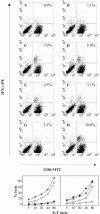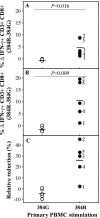A mutation in the HLA-B*2705-restricted NP383-391 epitope affects the human influenza A virus-specific cytotoxic T-lymphocyte response in vitro
- PMID: 15113903
- PMCID: PMC400375
- DOI: 10.1128/jvi.78.10.5216-5222.2004
A mutation in the HLA-B*2705-restricted NP383-391 epitope affects the human influenza A virus-specific cytotoxic T-lymphocyte response in vitro
Abstract
Viruses can exploit a variety of strategies to evade immune surveillance by cytotoxic T lymphocytes (CTL), including the acquisition of mutations in or adjacent to CTL epitopes. Recently, an amino acid substitution (R384G) in an HLA-B*2705-restricted CTL epitope in the influenza A virus nucleoprotein (nucleoprotein containing residues 383 to 391 [NP(383-391)]; SRYWAIRTR, where R is the residue that was mutated) was associated with escape from CTL-mediated immunity. The effect of this mutation on the in vitro influenza A virus-specific CTL response was studied. To this end, two influenza A viruses, one with and one without the NP(383-391) epitope, were constructed by reverse genetics and designated influenza viruses A/NL/94-384R and A/NL/94-384G, respectively. The absence of the HLA-B*2705-restricted CTL epitope in influenza virus A/NL/94-384G was confirmed by using (51)Cr release assays with a T-cell clone specific for the NP(383-391) epitope. In addition, peripheral blood mononuclear cells (PBMC) stimulated with influenza virus A/NL/94-384G failed to recognize HLA-B*2705-positive target cells pulsed with the original NP(383-391) peptide. The proportion of virus-specific CD8+ gamma interferon (IFN-gamma)-positive T cells in in vitro-stimulated PBMC was determined by intracellular IFN-gamma staining after restimulation with virus-infected autologous B-lymphoblastoid cell lines and C1R cell lines expressing only HLA-B*2705. The proportion of virus-specific CD8+ T cells was lower in PBMC stimulated in vitro with influenza virus A/NL/94-384G obtained from several HLA-B*2705-positive donors than in PBMC stimulated with influenza virus A/NL/94-384R. This finding indicated that amino acid variations in CTL epitopes can affect the virus-specific CTL response and that the NP(383-391) epitope is the most important HLA-B*2705-restricted epitope in the nucleoprotein of influenza A viruses.
Figures





References
-
- Apolloni, A., D. Moss, R. Stumm, S. Burrows, A. Suhrbier, I. Misko, C. Schmidt, and T. Sculley. 1992. Sequence variation of cytotoxic T cell epitopes in different isolates of Epstein-Barr virus. Eur. J. Immunol. 22:183-189. - PubMed
-
- Bertoletti, A., A. Costanzo, F. V. Chisari, M. Levrero, M. Artini, A. Sette, A. Penna, T. Giuberti, F. Fiaccadori, and C. Ferrari. 1994. Cytotoxic T lymphocyte response to a wild type hepatitis B virus epitope in patients chronically infected by variant viruses carrying substitutions within the epitope. J. Exp. Med. 180:933-943. - PMC - PubMed
-
- Bertoletti, A., A. Sette, F. V. Chisari, A. Penna, M. Levrero, M. De Carli, F. Fiaccadori, and C. Ferrari. 1994. Natural variants of cytotoxic epitopes are T-cell receptor antagonists for antiviral cytotoxic T cells. Nature 369:407-410. - PubMed
-
- Boon, A. C., G. de Mutsert, Y. M. Graus, R. A. Fouchier, K. Sintnicolaas, A. D. Osterhaus, and G. F. Rimmelzwaan. 2002. Sequence variation in a newly identified HLA-B35-restricted epitope in the influenza A virus nucleoprotein associated with escape from cytotoxic T lymphocytes. J. Virol. 76:2567-2572. - PMC - PubMed
Publication types
MeSH terms
Substances
LinkOut - more resources
Full Text Sources
Other Literature Sources
Molecular Biology Databases
Research Materials
Miscellaneous

